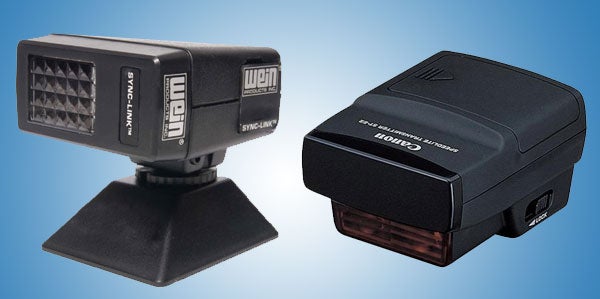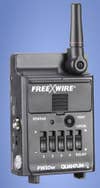Wireless Flash Triggers: Radio Vs. Infrared
What will work best for you when you're trying to get your flash off of your camera?

We may earn revenue from the products available on this page and participate in affiliate programs. Learn more ›
“Wires are for chumps,” declares Arizona pro Bruce Dorn.
If you agree and haven’t yet taken the wireless plunge, you have some decisions to make. First and foremost is how to go wireless: with an infrared or radio system.
Infrared systems such as those made by Canon and Nikon communicate using pulsating beams of light that travel in a direct line of sight between a camera-based transmitter and flash-based receiver.
Radio systems such as the popular PocketWizards, on the other hand, transmit their data via electromagnetic waves. They don’t require direct line of sight, but can communicate around corners, through walls, and across much further distances than light-based triggers.
The big flash makers have cast their lot with infrared systems. For one thing, laws regulating radio transmissions and their usable frequencies are different around the world. Infrared is also generally less expensive than radio and often offers TTL exposure controls.
For those two reasons alone, it’s great for beginners. Many flash units have built-in infrared receivers so you need only purchase a transmitter.
The downsides, besides the line of sight issue, are that IR receivers can have difficulty reading transmissions in bright daylight. (To minimize the problem, when setting up, don’t aim the receiver so it looks directly at the sun.) Also, their range is limited to between 10 and 40 feet, depending on the conditions, and some flash features — second curtain syncing, for example — aren’t supported by IR technology. To get the greatest possible distance from an infrared setup, make sure the transmitter and receiver are aimed at each other, and if necessary, move the transmitter closer to the receiver/flash combo with theta help of a TTL extension cord, such as those sold by OCF Gear.
Radio systems, on the other hand, can operate across hundreds of feet, but are subject to electronic interference and many do not offer TTL exposure control. The Interference can come from other photographers using the same system, or from ambient sources of electromagnetic energy. The well-known wedding photographer and entrepreneur Kevin Kubota, lists concrete buildings, large metal objects, electronic equipment, and general radio activity in the area among the sources he’s encountered. “To minimize interference, try to keep your units away from walls and floors and anything that’s humming like a swarm of angry bees,” he advises. “Keep your antennas up.”
If you can’t decide whether to go with IR or radio, try both. Many photographers do. For simple, fast setups, they opt for IR, but for more complex scenarios across wider distances, radio is the answer.
Another way to experience both: RadioPoppers. These transmitter/receiver sets attach to IR flash units and cameras. They receiver the IR commands emanating from the on-camera flash, convert them to radio waves and then reconvert them to IR data when they arrive at the flash. Sounds complicated, but it works.
{C}{C}
A FEW MORE OPTIONS
Most of you are likely already familiar with the offerings from PocketWizard, but there are other choices out there. Here’s a rundown of a few.
Wein SSR XT Infrared Transmitter ($104)
**

**
**Works On: **Infrared
**What’s Hot: **Talks to studio strobes
**What’s Not: **Not solid state. Can break if dropped.
Canon ST-E2 Infrared Transmitter
**

**
**Works On: **Infrared
**What’s Hot: **Works with all Canon bodies and flashes.
**What’s Not: **Not cheap.
Photoflex Flashfire Transmitter/Receiver Kit ($100)

Works on: Radio
What’s Hot: **That low, low price.
**What’s Not: By radio standards, range is short.
Quantum FreeXwire Flash Trigger ($194 for transmitter only)
**

****Works On: **Radio
**What’s Hot: **Compatible with the new QLink TTL system.
**What’s Not: **Bulky.